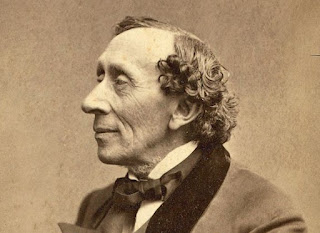by Julie Della Torre
Why tell the tales of Andersen? Are they relevant today?
 |
| HCA |
I love telling some of Andersen stories and do so frequently in classrooms. I’m able to show many illustrated versions demonstrating the popularity of the tales. Vibrant discussions follow many of the stories. There is always laughter and delight and often some quiet reflection.
The first reason to tell Andersen stories is the man himself and the genre of the fairy tale. Many, including Andersen, have called him ‘The Father of the Fairytale.’ The Grimm’s brothers and others before HCA gathered folktales and the folklore of cultures. In France, Beaumont, Perrault, and others told and wrote courtly, satirical romances. But Andersen invented stories.
Diana and Jeffrey Frank write in the introduction of their anthology (*)
“He had appropriated a traditional form but seemed simultaneously to invent a new one that accommodated itself to flights of fancy and humor, social attire, and literary revenge.”
Another reason to tell these tales is for the language. He was the first to write in colloquial Danish. Andersen wanted to write as people spoke. He wrote as a storyteller. It was shocking to reviewers, but the common people loved it. Marc Brown describes it perfectly in his 1990 article in Horn Book (‘The Artist at Work: The Importance of Humor’),
“A sentence from one of Hans Andersen’s Tales is utterly different from a sentence by anyone else. Perrault or Grimm would have written, “The children got into the coach and drove off,” but Hans Andersen wrote, “Up they go on the coach. Goodbye Mum. Goodbye Dad. Crack went the whip, whick, whack and away they dashed. Gee up! Gee up!”
It was talking. This language makes it difficult for translators. Many editions of the tales are dry and lack humor, for most translations go through the German first. The Franks’ translation is a rare example of the tales being directly translated from Danish into English.
Then there are the themes and subjects of Andersen’s tales. He was the first to have talking toys, darning needles and tin soldiers, and Moroccan leather balls falling in love with tops. He wrote of humanity in all its joys and disappointments, betrayals, silliness, pomposity, greed, and heartbreaks. He wrote of truth and falseness, of beauty and artifice. Hans Andersen experienced all of these emotions and painful experiences in his own life and struggled greatly. He put these feelings and struggles into the mouths and actions of common everyday objects allowing us all to see ourselves in these stories.
Hans Christian Andersen published 156 tales, enough to find every emotion and foible experienced by humankind. Because of this the stories resonate to this day. I’ve been asking people, “Do you think it’s still important to tell Hans Christian Andersen stories?” My favorite response came from my husband who just rolled his eyes and without hesitation responded, “Really? With the world today? The Emperor’s New Clothes says it all. What other story do you need?”
The influence of Hans Andersen is vast. Authors such as Yolen, Philip, Rowling, and many more have taken the fairy tale form and made it their own. Illustrators over the years have been inspired to bring these tales to life visually. Storytellers have been inspired to bring the language, the characters and stories to life through the oral art form.
Go find a translation you like, read through some of the tales and start telling Andersen. Enjoy!
*The Stories of Hans Christian Andersen translated by Dianna and Jeffery Frank. Houghton Mifflin. 2003.


No comments:
Post a Comment